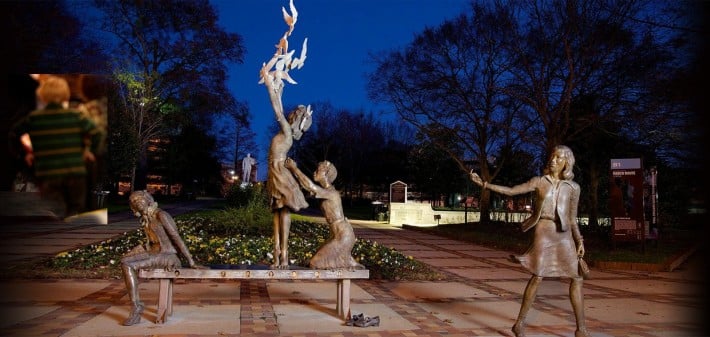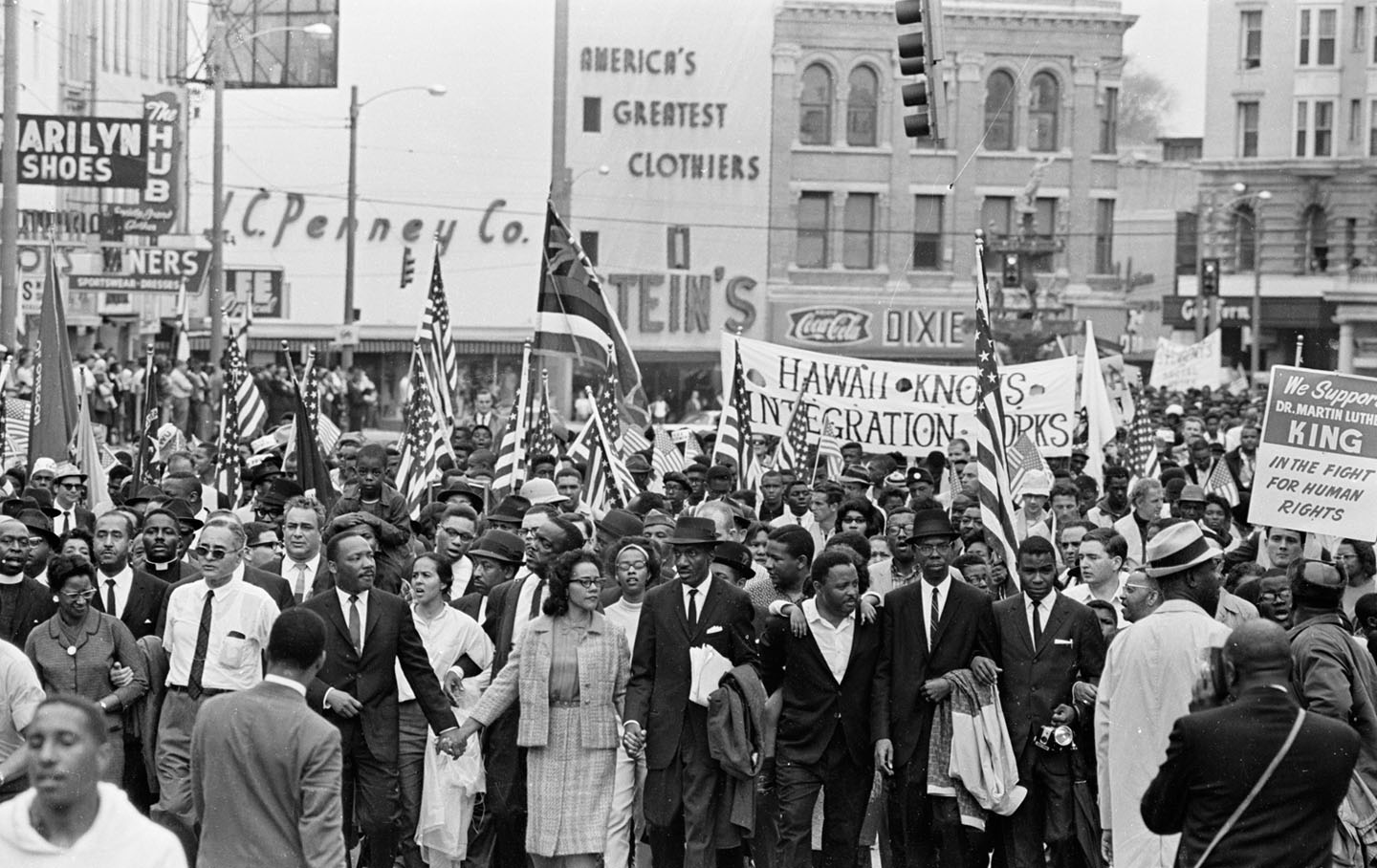-
10 February 2023
Birmingham – Before the 16th Street Baptist Church in Birmingham, Alabama was bombed on Sunday, September 15, 1963, the church secretary, Mrs. Shorter, a 75-year-old woman received several phone threats. She was unnerved by the calls, but others ignored her concern. Bombing was a common threat.
The last call to the 16th Street Baptist Church was brief. The caller just said, “three minutes.” A twelve-year-old girl was alone in the office and answered the phone. She was at the church preparing for a meeting. Her girlfriends were in a bathroom, in the way that teenage girls will gather. Addie, Denise, Cynthia, and Carol were preparing for their role in an inaugural teen leadership event in the sanctuary above. The church was overflowing with worshippers that Sunday.
Then the bomb went off in an outdoor stairway, below the sanctuary and adjacent to the bathroom. The four girls died. Twenty-two were injured. Hundreds were traumatized.
There is a statue commemorating the tragedy in the park across from the church. Four girls are depicted in the statue. One is bent over a bit as her friend ties the sash on her dress. Six doves are ascending above the girls. Four of the doves represent the girls. The other two represent two black boys also murdered that day.
Many of the 16th Street Baptist Church’s members were active in the civil rights movement. After the bombing, membership dropped from 800 to 400 families. Fear gripped the community. Fear of losing jobs. Fear of bodily harm. Fear of death.
There was a total of 60 unsolved bombings in Birmingham. The police made nearly no attempt to find the criminals. The city became known as “Bombingham.”
Historians attribute the passage of the Civil Rights Act of 1964 as a direct reaction to this bombing. The murder of four young girls is sickening enough. The bombing of a church is a terrible affront to all people of faith. This is especially true of the Black communities in the South where the Church was a second home and one of the few places where they could gather freely and without restrictions.
Birmingham had long been the scene of horrific violence against African Americans. Jews know what it is like to have houses of worship attacked. Jews have been shot, on the streets and in our synagogues. Yet, another form of violence was enigmatic of racism in America – lynching. Birmingham was the scene of many. Black bodies hanging from trees, sometimes broken and bloodied, sometimes riddled with bullets. At least 30 lynchings occurred in Jefferson County, Alabama.
I could relate to racism against Blacks through my familiarity with antisemitism. Jews had been ostracized, ghettoized, and murdered. But lynching is particularly enigmatic of the African American experience. Lynching was both fevered and deliberate. Lynching was both a signal and a spectacle. Lynching may have killed one person but was directed against all Black people. Racists had a lust to bring about submission through terror.
The 16th Street Church bombing in 1963 so shocked the nation as to evoke a cry for change. Many more attacks on houses of worship have occurred since then. The white supremacists in America keep calling us. To these hellions, black lives don’t matter.

Southern Jews and Jewish Values – Jews had long participated in the American South. The South was host for Jewish immigrants hoping to live the American Dream. Yet, that dream was marred by discrimination and segregation.
Jewish communities thrived throughout the South during times of Jim Crow segregation. They had cordial relationships with their Christian neighbors. Jews had retail businesses and relied upon White Christian customers. And Jews of the South generally refrained from participation in the civil rights movement.
We learned more when visiting the only remaining synagogue in Selma. Temple Mishkan Israel stands on Broad Street in the heart of Selma, Alabama’s downtown. There are three members remaining. Not three families. Three members. We met with Ronnie Leet and watched a video about the synagogue. The video was also a fundraising pitch. The building needs $5 million of repairs. Leet argued for preservation of the building as the only way to tell the story of Selma’s once thriving Jewish community.
Of interest to our group was how Leet and his family viewed the civil rights movement. They watched from a distance. They had a retail store. They needed to work every day. They had long participated in society with their white Christian neighbors, and the Leets feared upsetting those relationships. While his family may have been sympathetic to their Black neighbors, civil rights was not their fight.
Ronnie Leet’s answer was direct and honest. Like the Leets, most of us focus on our families, our livelihoods, and our health. We might take interest in the news and donate to causes. Human nature is inclined toward stasis, even if the arc of the universe leans toward justice.
Jews believe in truth and justice. We celebrate freedom every Sabbath and every Passover. We helped Soviet Jews escape repression. But supporting Soviet Jews did not jeopardize our jobs. We were writing checks to help Israel on Yom Kippur in 1973. But supporting Israel did not imperil our families.
Some will argue that we have an obligation to our own people before we can help others. I might agree with that argument if we were a people of limited resources and limited power. But American Jews have more wealth and more power now then any Jewish people in over 2,000 years. Our place in America is secure, despite episodes of antisemitism.
I don’t condemn the Selma Jewish community of the mid-20th century; they were afraid, and fear often motivates us to protect ourselves.
The Southern Jewish communities are dwindling in size. Rarely do Jews live and work where their futures are in peril. Life for Jews in America has changed in the past 60 years. Discrimination against African Americans continues.

Selma – The morning in Selma, Alabama was extremely foggy. It was hard to see the Alabama river below the bridge into town. We turned off the bridge onto Water Street. Stepping down from the bus, we entered one of the old brick buildings along the waterfront. And then the day slowly began to clear.
Selma had recently been in the news. An F-2 tornado touched down in January devastating parts of the city. But that was not why this group of rabbis came to town. Selma has another dark and stormy history spanning centuries. Selma is emblematic of a small Southern segregated city.
We stood on Water Street, just a few dozen feet away from the spot where boats would dock. For decades, this is where slaves arrived in Selma.
After the Civil War, Southern states denied their African American citizens’ basic human rights. In 1896, the Supreme Court affirmed laws that gave separate but equal treatment to Blacks. Of course, in practice, these laws denied Blacks their rights to a good education, equal access to government services, or participation in commerce. Chief among these rights is the right to vote. Through various restrictions such as poll taxes and literacy tests, Southern states were able to prevent Blacks from registering. By the 1950s, only two percent of Blacks in Selma could vote. For that reason, Selma became the focal point of the efforts to secure voting rights for Blacks.
Civil Rights leaders feared the backlash from attempts to desegregate Selma. Yet, Dr. Bernard Lafayette convinced the leadership to send him to Selma. His efforts laid the groundwork for the historic march from Selma to the state capital, Montgomery, Alabama. The only road to Montgomery required crossing a bridge named for a Confederate general and KKK (Ku-Klux-Klan) leader. It took three attempts for the marchers to walk from the Brown Chapel AME Church over the Edmund Pettus Bridge.
The first attempt was on March 7, 1965. Six hundred marchers were met with horrendous violence from the police and local men deputized for this purpose. It is known as Bloody Sunday in American history. The next week, with the support of Federal Troops, the marchers made it across the bridge on a five-day, 50-mile trek to the capital, demanding voting rights.
My first steps in Selma were into the By the River Center for Humanity. We met Sister Afriye We-kandodis who leads life-changing experiences. We sampled some of her soul work. In her presentation, she shared a belief that healing is achieved when we acknowledge the totality of the past. Our work is to love ourselves and overcome fear. Her healing techniques included sound, movement, and performance to achieve spiritual and emotional releases.
Picture this scene. 20 white Jewish leaders in a wide circle, hugging themselves and screaming “I love myself.” With inspirational music blaring, many took turns dancing in the circle’s center with Afriye. Her faith was so strong, that all were swept up in the love and fully engaged in the activity.
We later walked across the Edmund Pettus Bridge. The sunshine brushed aside the fog and cloudiness. We sang: “Kol Haolam Kulo Gesher Tzar M’od,” all the world is a narrow bridge. The main thing is not to fear. We walked quietly. Our steps followed the steps of civil rights heroes. We were walking on holy ground.
The challenge today is to keep walking across those bridges.
